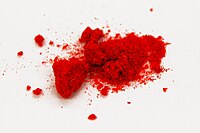Tris(bipyridine)ruthenium(II) chloride
 |
|
 |
|
| Names | |
|---|---|
| Other names
Ru-bpy
Ruthenium-tris(2,2’-bipyridyl) dichloride |
|
| Identifiers | |
|
|
| ECHA InfoCard | 100.034.772 |
| RTECS number | VM2730000 |
| Properties | |
| C30H24N6Cl2Ru·6H2O | |
| Molar mass | 640.53 g/mol (anhydrous) 748.62 g/mol (hexahydrate) |
| Appearance | red solid |
| Density | solid |
| Melting point | >300 °C |
| slightly soluble in water; soluble in acetone | |
| Structure | |
| Octahedral | |
| 0 D | |
| Hazards | |
| Main hazards | mildly toxic |
| R-phrases (outdated) | none |
| S-phrases (outdated) | S22 S24/25 |
| Related compounds | |
|
Related compounds
|
Ruthenium trichloride |
|
Except where otherwise noted, data are given for materials in their standard state (at 25 °C [77 °F], 100 kPa).
|
|
|
|
|
| Infobox references | |
Tris(bipyridine)ruthenium(II) chloride is the coordination compound with the formula [Ru(bpy)3]Cl2. This red crystalline salt is obtained as the hexahydrate, although all of the properties of interest are in the cation [Ru(bpy)3]2+, which has received much attention because of its distinctive optical properties. The chlorides can be replaced with other anions, such as PF6−.
This salt is prepared by treating an aqueous solution of ruthenium trichloride with 2,2'-bipyridine. In this conversion, Ru(III) is reduced to Ru(II), and hypophosphorous acid is typically added as a reducing agent. [Ru(bpy)3]2+ is an octahedral coordination complex. The complex is chiral, with D3symmetry. It has been resolved into its enantiomers, which are kinetically stable. In excited state the molecule loses symmetry and attains C2 symmetry, as the transferred electron doesn't distribute symmetrically to the 3 bipyridyl ligands in the lowest lying triplet excited state.
[Ru(bpy)3]2+ absorbs UV light and visible light. In aqueous medium the molecule strongly absorbs at 452 ± 3 nm corresponding to MLCT transition (extinction coefficient of 14,600 M−1cm−1), 285 nm corresponding to ligand centered π*← π transition and a weak transition around 350 nm (d-d transition). Solutions of the resulting excited state have a comparatively long lifetime of 890 nanoseconds in acetonitrile and 650 ns in water. The excited state relaxes to the ground state by emission of a photon at the wavelength of 620 nm. The long lifetime of the excited state is attributed to the fact that it is triplet, whereas the ground state is a singlet state and in part due to the fact that the structure of the molecule allows for charge separation. Singlet-triplet transitions are forbidden and therefore often slow.
...
Wikipedia
